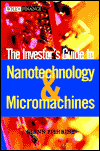
Other books by
Glenn Fishbine
(click to learn more)
By Glenn Fishbine
PHYSICS WORLD
How to get rich through nanotechnology - Roger Carline
Review: August 2002
Glenn Fishbine obviously knows his microtechnology. In this book, he attempts to peel away the layers of technobabble, acronyms and hype to show the investor how to gain commercial advantage in the field and to reveal the truth behind the technology promises made by "the experts".
All in all, the author has done a good and entertaining job of breaking down, ordering and assessing a fair chunk of the technologies currently being developed, and providing a valuable insight into their commercial potential. If anything, this is the main strength of the book as it provides potential investors with a starting point for understanding and locating opportunities.
Despite his obvious enthusiasm for the technology, the author attempts to give a realistic assessment of opportunities, particularly the time lines for real products. The text is written at a level that will enable even non-scientists to glean the basic technological principles. And because so many different topics are covered, those readers who are technologically literate will find many useful facts for discussion over dinner.
INVESTMENT
ADVISOR MAGAZINE
Technicalities - Marlene Y. Satter
Review:
September 2002
If you want better understanding of the technology youíll be using soon,
and perhaps the kind of tech company stocks that will be leaders in the
years to come, read these books. After all, while the idea of reading
up on the technology field may seem daunting, the truth is that it can
be fun, too. For instance, whatís the first known instance of a commercially
viable use of nanotechnology? For that matter, what is nanotechnology?
The answers to these and other fascinating questions can be found in The
Investorís Guide to Nanotechnology & Micromachines.
In this thoroughly entertaining and educational book, Fishbine not only deals with the realities of defining opportunities for investing in nanotechnology, he explains what it is, gives a brief history of various facets of the field, and explores several applications in which commercial opportunities may be found. Whether heís discussing imaging systems, control systems, or the real nitty-gritty of quantum mechanics (quoting the famous Schroedinger: "I donít like it, and Iím sorry I ever had anything to do with it" or Richard Feynmann, a "significant contributor to the theory": "I think that I can safely say that nobody understands quantum mechanics"), Fishbine does so with humor, understanding, and a style of explanation that neither intimidates nor obfuscates.
The
first part of the book offers ways of sniffing out investing opportunities
in the field of nanotechnology one of the best ways is to check on whatís
being done at colleges, universities, and government agencies and to an
explanation of how the research and investing system works. While you
might think that this section is the main area of interest to investors,
youíd be much in error to skip the rest of the book, with its discussions
on the development of all sorts of technological advances and how these
relate to or segue into modern technologies. Fishbine shines throughout
the book, and youíll find yourself reluctant to put it down.
Ken Buckingham, Founder, Tiny Technology, Inc.
Nanotechnology is already here and investment opportunities in the field
are on the horizon. Glenn Fishbine expertly weaves investment wisdom,
a high degree of technical accuracy and completeness and his subtle brand
of humor to yield a work that I will recommend to anyone interested
in nanotechnology or future investments.
Fishbine guides the readers through the critical issues surrounding nanotechnology investment, keeping them from the mire of investment promises hyperbole and technical obfuscation.
In
addition to serving as a primer about nanotechnology, it makes an excellent
resource book replete with numerous helpful appendices.